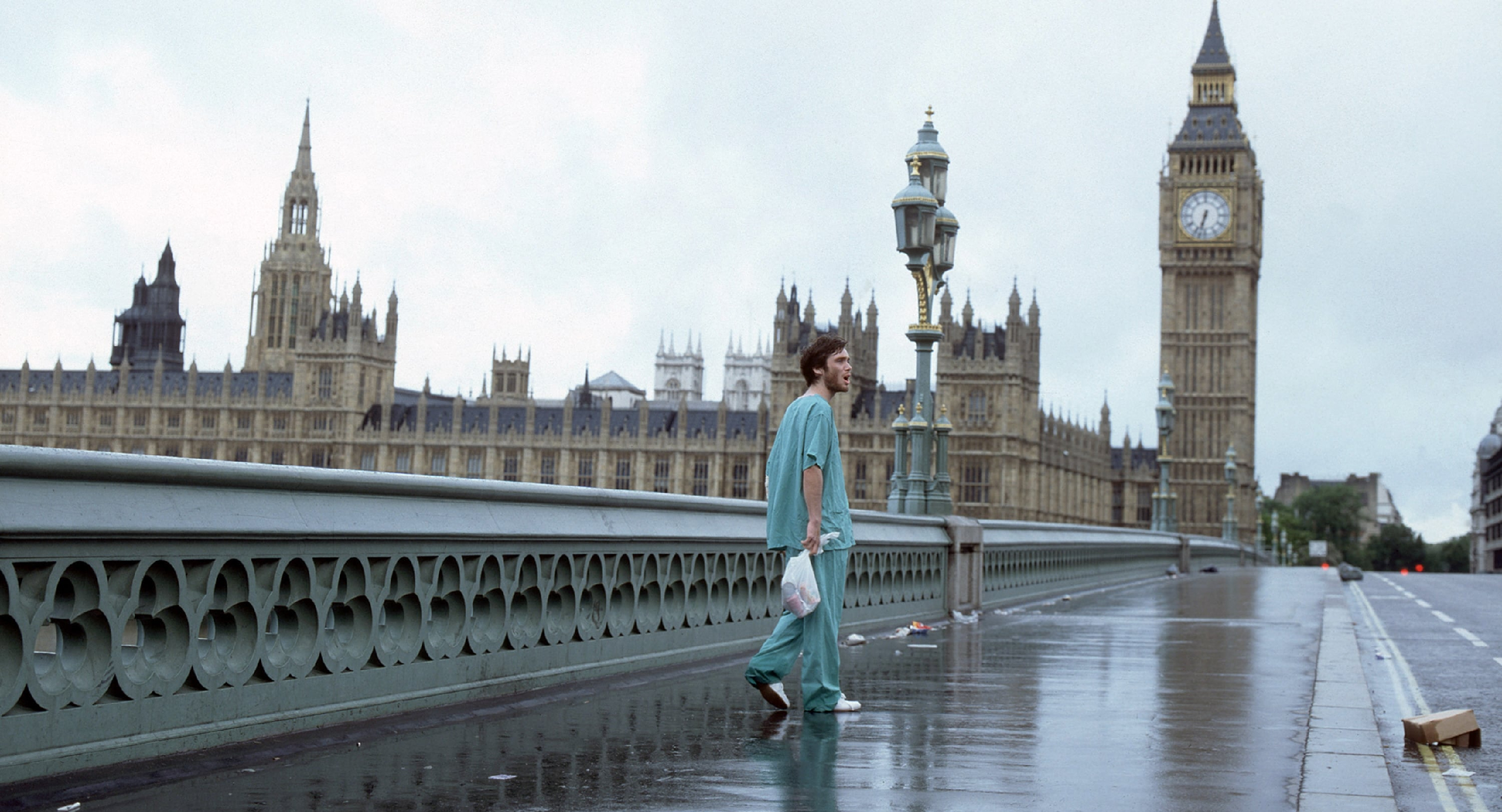28 Days Later – Film Review
Published July 11, 2023

A group of misguided animal rights activists free a caged chimp infected with the “Rage” virus from a medical research lab. When London bike courier Jim wakes up from a coma a month after, he finds his city all but deserted. On the run from the zombie-like victims of the Rage, Jim stumbles upon a group of survivors, including Selena and cab driver Frank, and joins them on a perilous journey to what he hopes will be safety.
In the realm of horror cinema, there are certain films that manage to leave an indelible mark on the genre, pushing boundaries and redefining what we think of as scary. Danny Boyle‘s 2002 film, 28 Days Later, is undoubtedly one such film. With its innovative approach, atmospheric storytelling, and exceptional performances, 28 Days Later stands as a masterpiece of the genre, deserving of its reputation as a modern classic.
From the very opening scene, Boyle sets the tone for the film, immersing the audience in a haunting and desolate atmosphere. We are introduced to Jim, played by the brilliant Cillian Murphy, who wakes up from a coma in an abandoned hospital. As he stumbles through the empty corridors, Boyle’s use of close-ups and tight framing amplifies Jim’s disorientation and our own sense of unease. The imagery of a post-apocalyptic London, eerily devoid of human life, is both captivating and unsettling.
The strength of 28 Days Later lies not only in its horror elements but also in its exploration of human nature and the breakdown of society. The film delves into themes of isolation, survival, and the depths to which humanity can sink in desperate times. Boyle, along with screenwriter Alex Garland, crafts a narrative that keeps the audience engaged and emotionally invested. The characters, though facing unimaginable horrors, remain relatable and believable throughout, making their struggles all the more poignant.
One aspect that sets 28 Days Later apart from traditional zombie films is the speed and aggression of its infected. These are not your slow-moving, shuffling creatures, but rather rabid, fast-moving predators. This change injects a level of intensity and fear that keeps the audience on the edge of their seats. Boyle’s frenetic camerawork and clever editing enhance the sense of chaos and panic, creating a visceral viewing experience. The infected are not merely mindless monsters; they are a relentless force that poses a constant threat, adding a sense of urgency to every scene.
The cinematography of 28 Days Later is another standout element of the film. Anthony Dod Mantle‘s handheld camerawork, combined with the use of digital video, gives the film a gritty and raw aesthetic. The desolate landscapes and abandoned cityscapes are captured with a haunting beauty, while the close-ups and frenzied action sequences intensify the horror. The color grading, emphasizing muted tones, adds to the atmosphere of despair and hopelessness.
The film’s score, composed by John Murphy, is a masterclass in tension-building and emotional resonance. From the hauntingly beautiful piano piece that accompanies the opening scenes to the pulse-pounding electronic beats during the film’s most intense moments, the music perfectly complements the visuals and amplifies the emotional impact. The juxtaposition of silence and music is expertly utilized, heightening both the quiet moments of contemplation and the heart-pounding sequences of terror.
Perhaps one of the film’s greatest strengths is its ability to elicit genuine emotional responses from the audience. While 28 Days Later is undeniably a horror film, it also serves as a character-driven drama. The relationships that develop between the survivors, particularly Jim and Selena (played by Naomie Harris), are complex and beautifully portrayed. The film explores themes of trust, sacrifice, and the will to survive, allowing the audience to connect with the characters on a deeper level.
In terms of criticism, one might argue that the third act of the film does not quite match the intensity and effectiveness of the first two acts. The introduction of a group of soldiers feels somewhat clichéd and predictable, detracting slightly from the unique atmosphere and tension built up until that point. However, even with this minor flaw, 28 Days Later remains a remarkable achievement in the genre.
28 Days Later is an exceptional horror film that transcends the genre’s conventions. Danny Boyle’s masterful direction, combined with a compelling narrative, outstanding performances, and striking cinematography, result in a film that is equal parts terrifying and thought-provoking. It is a rare gem that successfully balances horror with emotional depth, leaving a lasting impact on the viewer. Even after all these years, 28 Days Later remains a benchmark for modern horror cinema and an absolute must-watch for fans of the genre.
